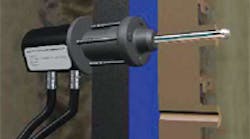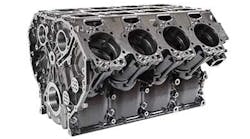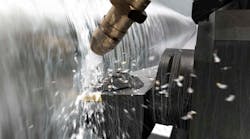The main advantage of 5-axis machining is the ability to save time by machining complex shapes in a single setup.
However, a major challenge is to hold the part firmly while making sure that the machine has access to workpiece surface areas. Traditional workholding devices often can’t do that for five-axis machines.
Providing greater workpiece access helps to deliver the economic advantage of 5-axis machining, and allows shops to use shorter tools to reach difficult surfaces, and shorter tools provide greater accuracy, improved surface finishes and a reduction in post-machining operations.
Prior to the advent of 5-axisspecific workholding, shops were limited in their ability to do multi-sided machining of parts while maintaining sufficient workholding forces, in one operation. For example, to machine six sides of a cubeshaped part, more than two operations usually would be required. With workholding devices that are placed around the perimeter of the part to secure it, access to workpiece features was limited.
The growth of 5-axis machining spawned several innovations in workholding.
One approach, developed by Innovative Technologies Unlimited (www.Ituclamps.com) is to hold parts from the side that is against the fixture.
ITU clamps work through the fixture and from behind the part to draw it back against the fixture. The clamps allow fivesided machining to be done on parts that are too difficult to hold by conventional methods.
ITU clamps replace bulky and intrusive swing clamps with an inhole diametrical wall clamp or a through-hole edge gripping clamp.
ITU clamps focus clamping forces directly over part locating surfaces. That reduces surface, tolerance and feature distortions that are inherent in conventional clamping methods.
Workpieces are clamped by diametrical wall clamps that expand in blind holes in the workpieces.
Parts are lowered, manually or through automation, over the clamps and onto the locating surface. Then the clamps are activated, either pneumatically or hydraulically, and the arbor expands the grippers against the walls of the blind holes to pull the part tight against the locating surface and to ensure good part location. The part now is secured into the fixture and ready for the manufacturing process.
Edge gripping clamps work in a similar way except that the clamps extend through pre-drilled holes in a workpiece. Once a workpiece is loaded, the clamps are activated, and expand to grip and pull down the backside of the holes to lock the part into the fixture.
ABS Manufacturing Systems, a large mid-western manufacturing company, has used both types of ITU clamps to fixture 20-lb aluminum cylinder heads, 60-lb cast iron flywheel housings, 110-lb ductile iron diesel cylinder heads and various other parts.
The company was concerned with combining part workholding with a fully automated robotic load system because of problems with spring-return swing clamps and the potential for failure of these devices. When springs break, the clamps do not return and remain engaged with the part.
Unfortunately, automated loading systems cannot detect when that happens and could attempt to remove the part. That usually damages the parts, the fixture and the clamps.
ABS was able to circumvent that issue by using ITU clamps with dual-actuated hydraulic cylinders to advance and retract the clamps. The clamps have only one moving part and no springs to worry about.
Lee Hawkins, manufacturing engineer at ABS said, “We use both types of ITU clamps and they have allowed us to reduce the number of operations on an important job we were quoting for GM Powertrain. We were able to reduce from four value-added operations to just three allowing us to eliminate the costs inherent with added operations.
“The clamps worked so well that we started using them where we had problems with conventional swing clamps that were distorting workpieces. Part geometry can sometimes force you to clamp over undesirable areas, such as in between rest pads. This causes the part to bend during machining resulting in an out-offlat condition. In one case, a quality problem was attributed to clamp placement. We replacing the swing clamps with the ITU Edge-Gripping Clamps and were able to secure the part from below the fixture and directly over the rest pad. This eliminated part distortion and








